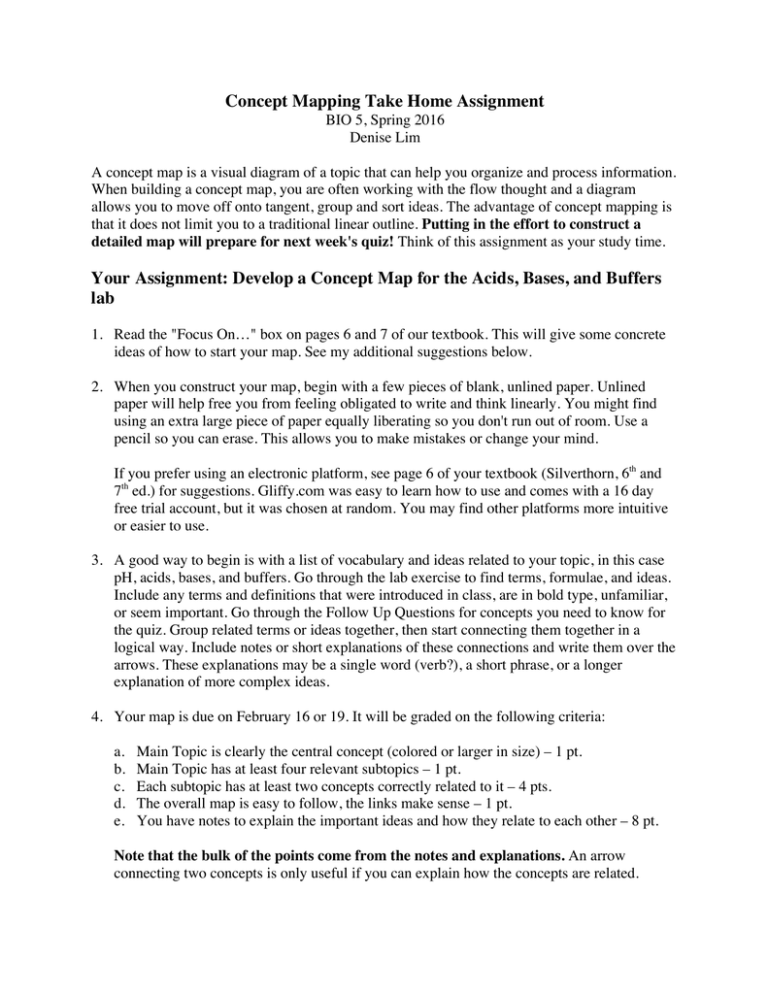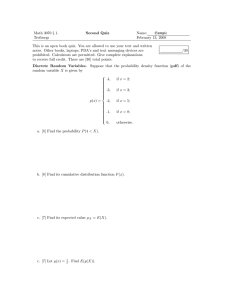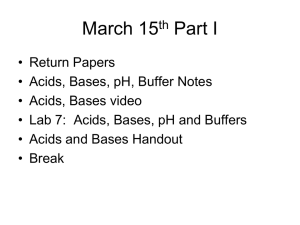Concept Mapping Take Home Assignment
advertisement

Concept Mapping Take Home Assignment BIO 5, Spring 2016 Denise Lim A concept map is a visual diagram of a topic that can help you organize and process information. When building a concept map, you are often working with the flow thought and a diagram allows you to move off onto tangent, group and sort ideas. The advantage of concept mapping is that it does not limit you to a traditional linear outline. Putting in the effort to construct a detailed map will prepare for next week's quiz! Think of this assignment as your study time. Your Assignment: Develop a Concept Map for the Acids, Bases, and Buffers lab 1. Read the "Focus On…" box on pages 6 and 7 of our textbook. This will give some concrete ideas of how to start your map. See my additional suggestions below. 2. When you construct your map, begin with a few pieces of blank, unlined paper. Unlined paper will help free you from feeling obligated to write and think linearly. You might find using an extra large piece of paper equally liberating so you don't run out of room. Use a pencil so you can erase. This allows you to make mistakes or change your mind. If you prefer using an electronic platform, see page 6 of your textbook (Silverthorn, 6th and 7th ed.) for suggestions. Gliffy.com was easy to learn how to use and comes with a 16 day free trial account, but it was chosen at random. You may find other platforms more intuitive or easier to use. 3. A good way to begin is with a list of vocabulary and ideas related to your topic, in this case pH, acids, bases, and buffers. Go through the lab exercise to find terms, formulae, and ideas. Include any terms and definitions that were introduced in class, are in bold type, unfamiliar, or seem important. Go through the Follow Up Questions for concepts you need to know for the quiz. Group related terms or ideas together, then start connecting them together in a logical way. Include notes or short explanations of these connections and write them over the arrows. These explanations may be a single word (verb?), a short phrase, or a longer explanation of more complex ideas. 4. Your map is due on February 16 or 19. It will be graded on the following criteria: a. b. c. d. e. Main Topic is clearly the central concept (colored or larger in size) – 1 pt. Main Topic has at least four relevant subtopics – 1 pt. Each subtopic has at least two concepts correctly related to it – 4 pts. The overall map is easy to follow, the links make sense – 1 pt. You have notes to explain the important ideas and how they relate to each other – 8 pt. Note that the bulk of the points come from the notes and explanations. An arrow connecting two concepts is only useful if you can explain how the concepts are related.



